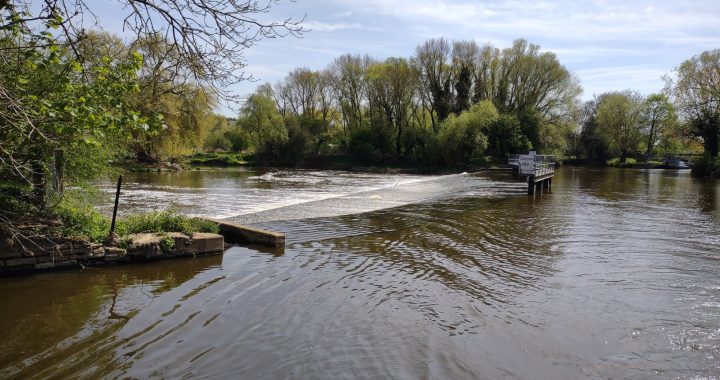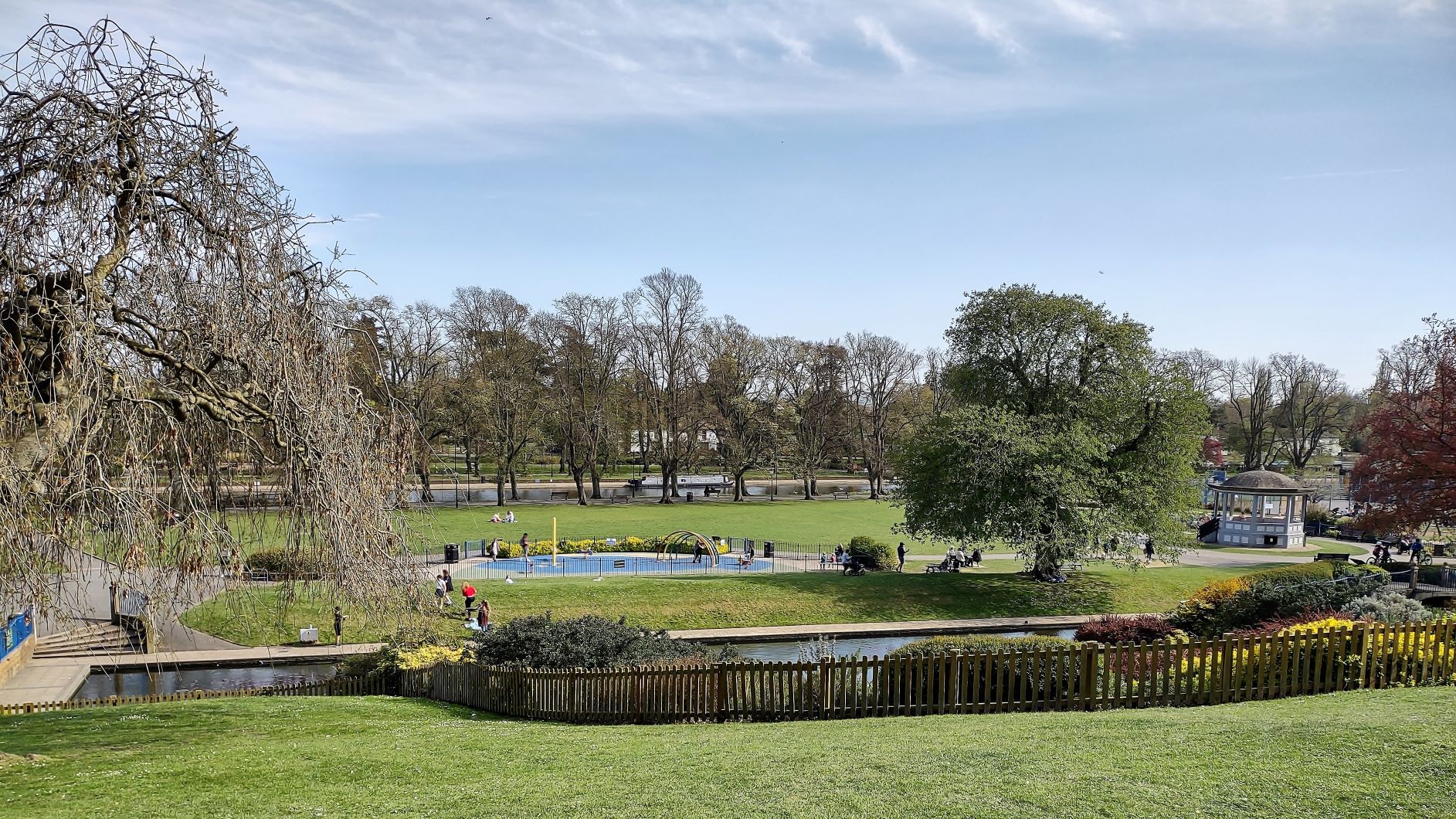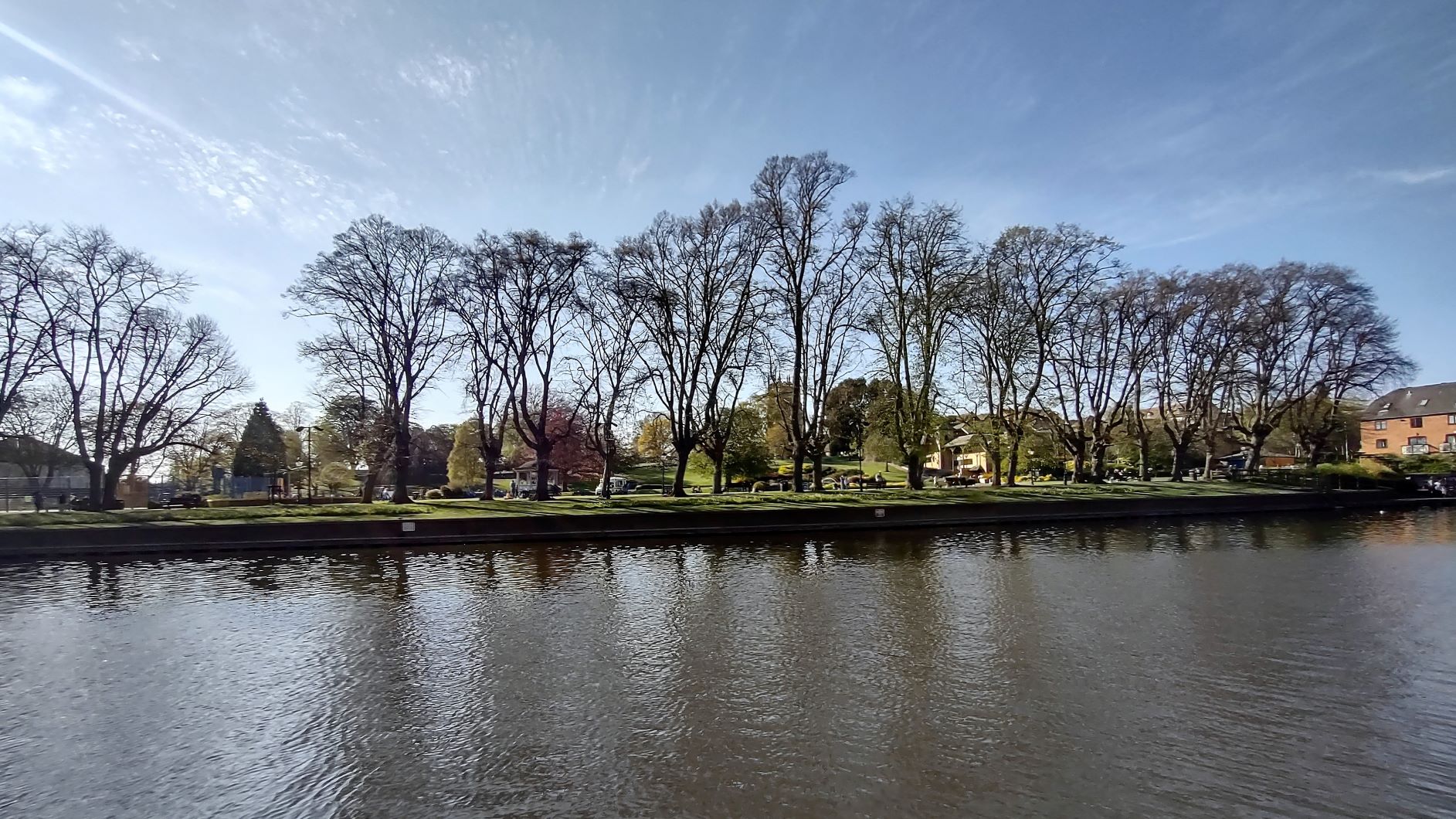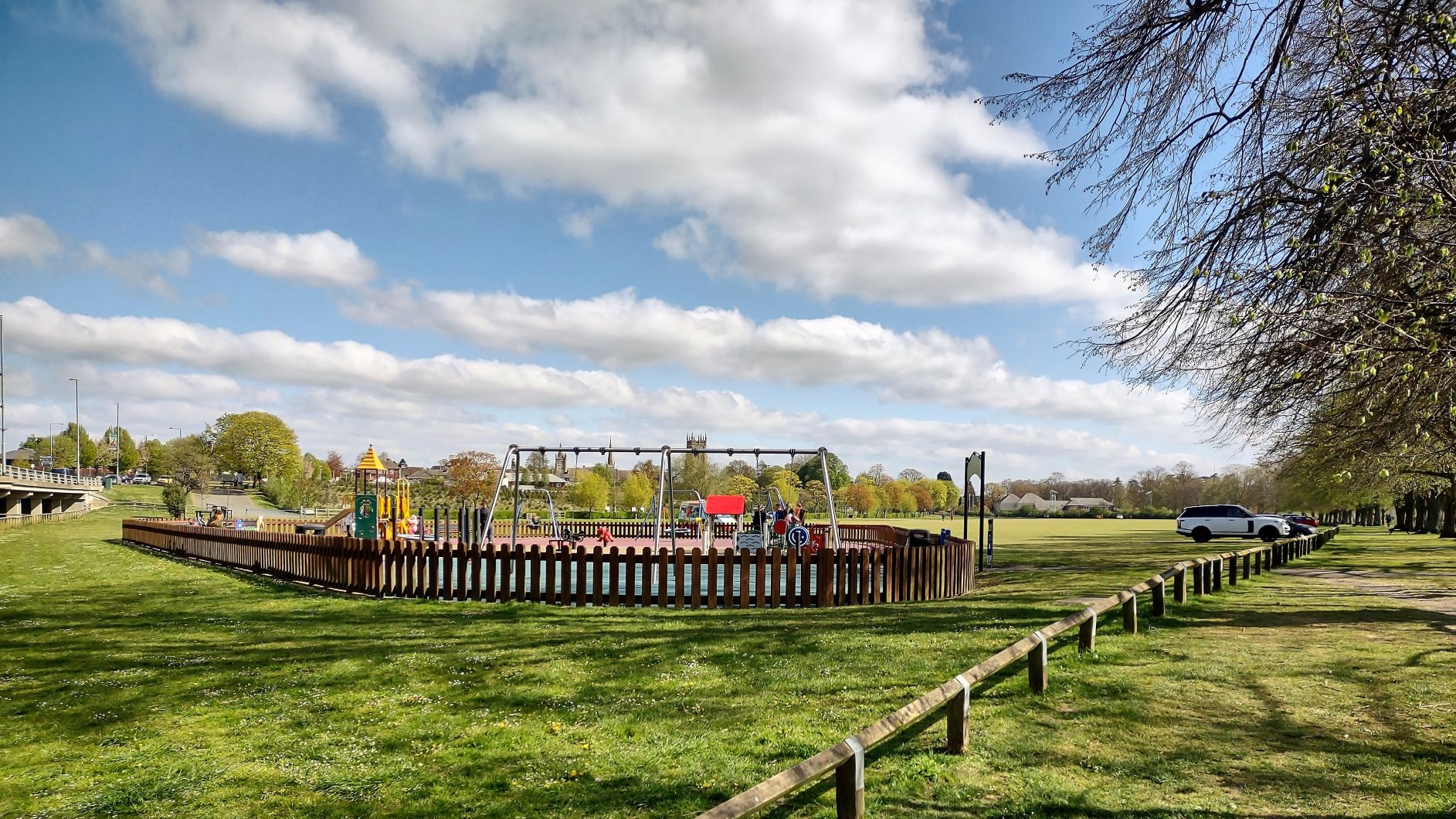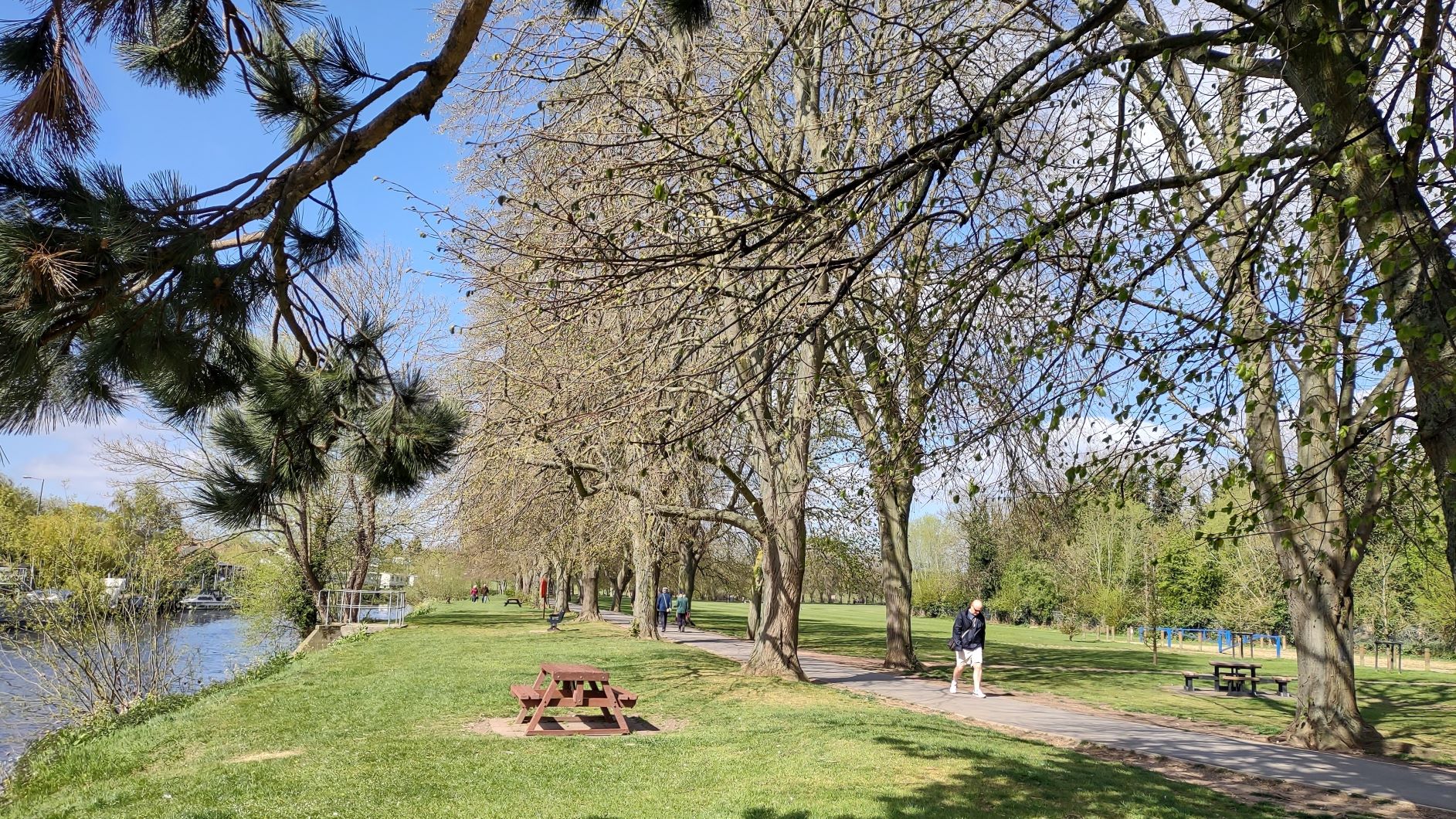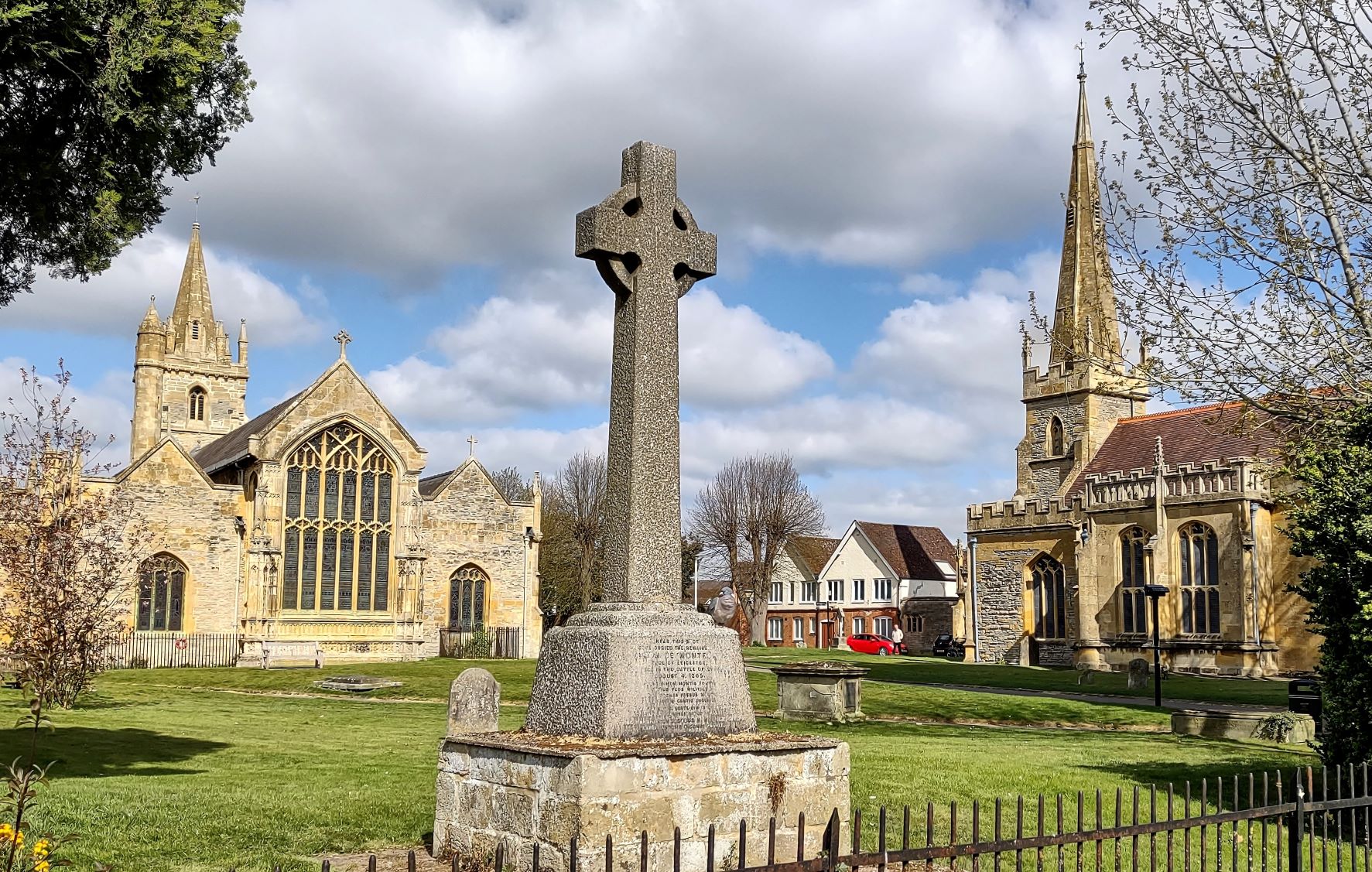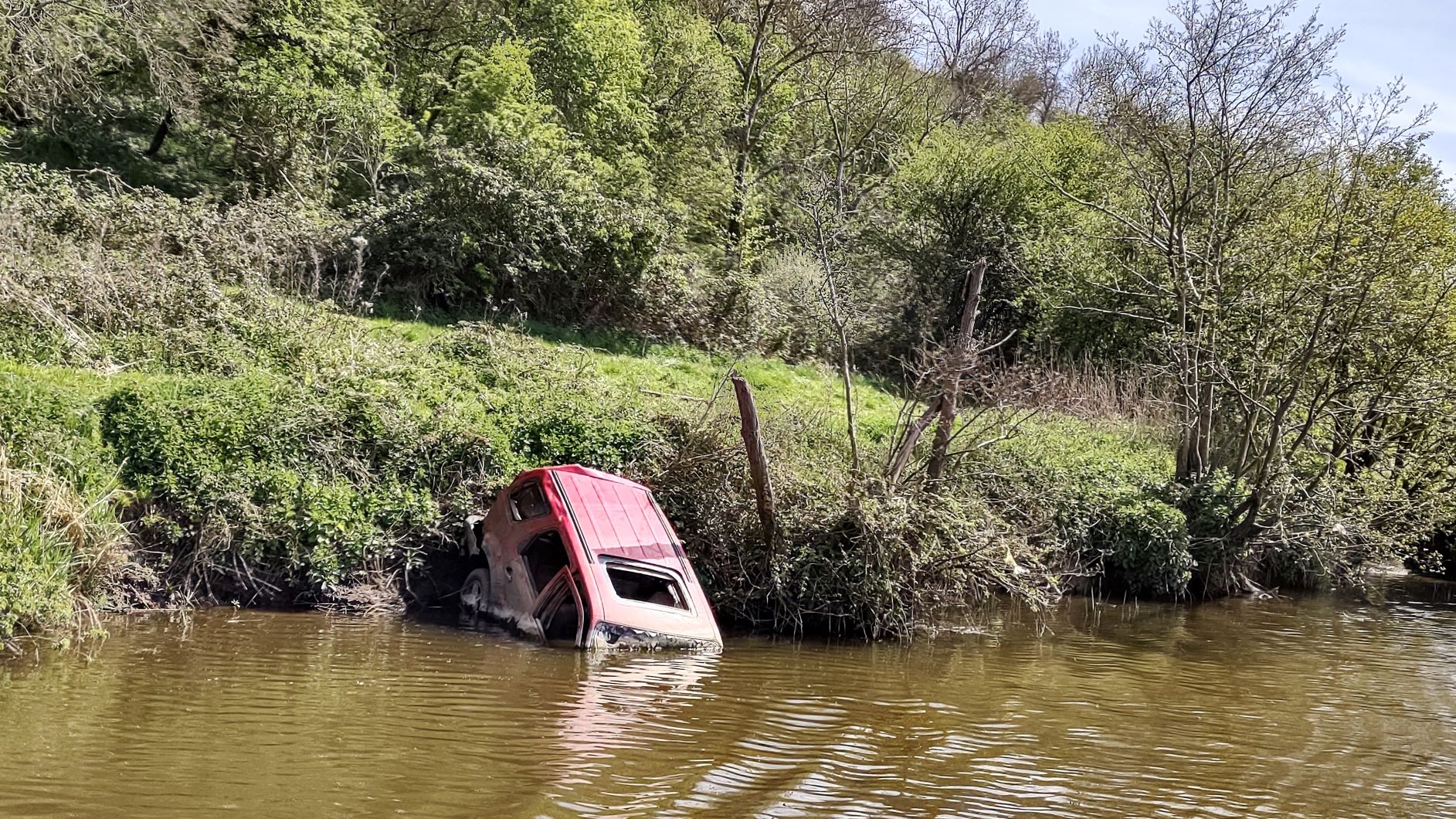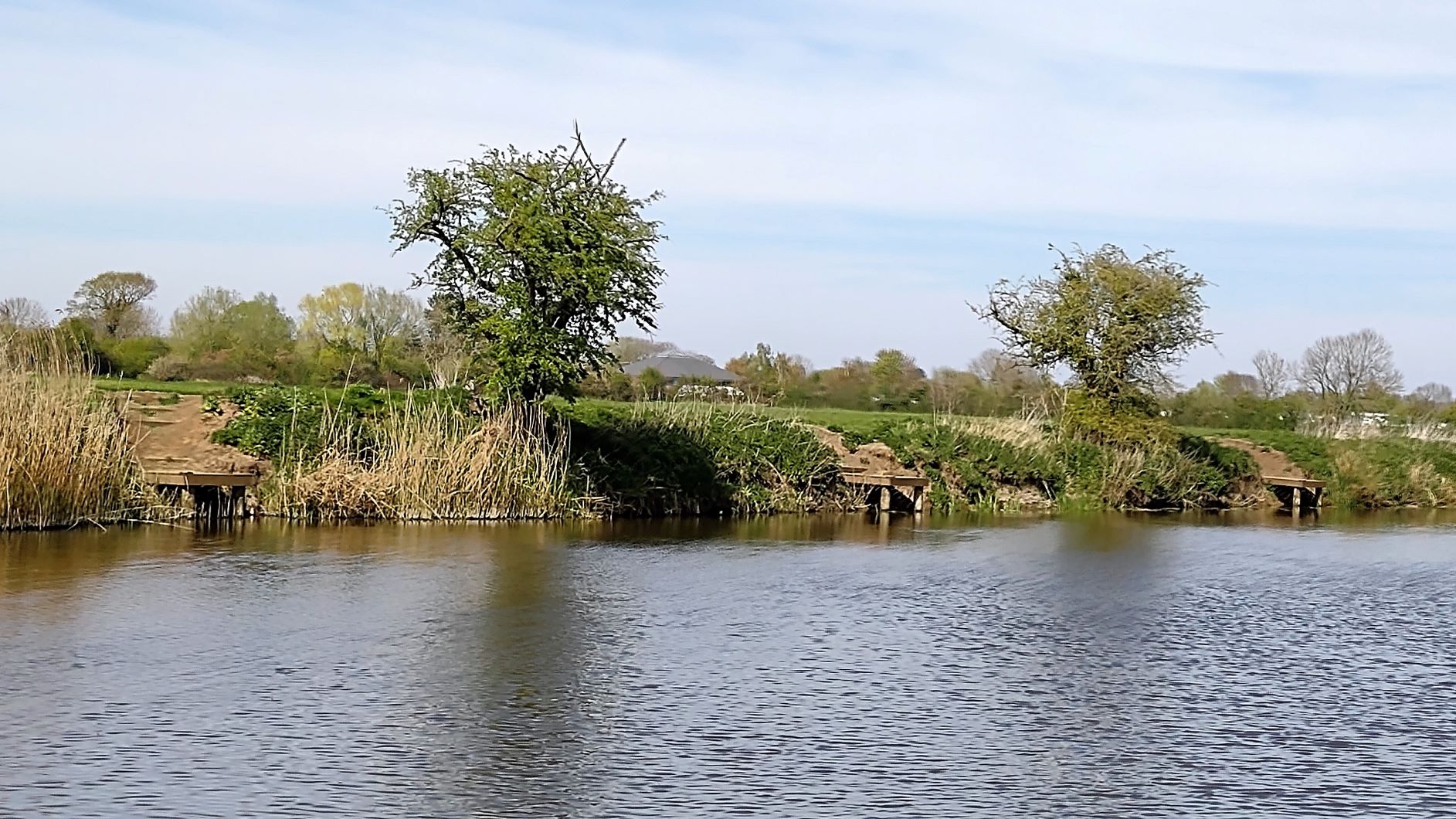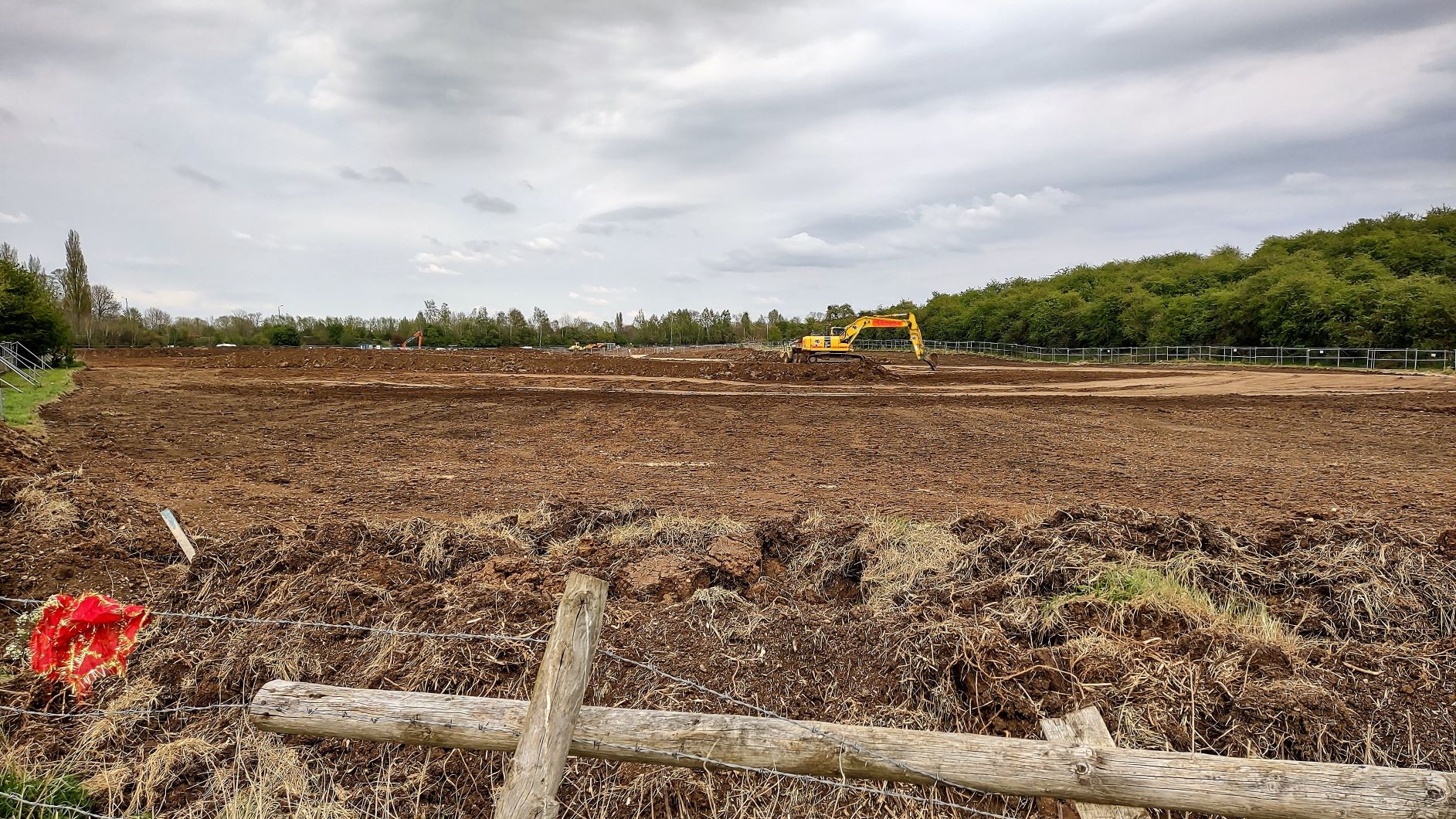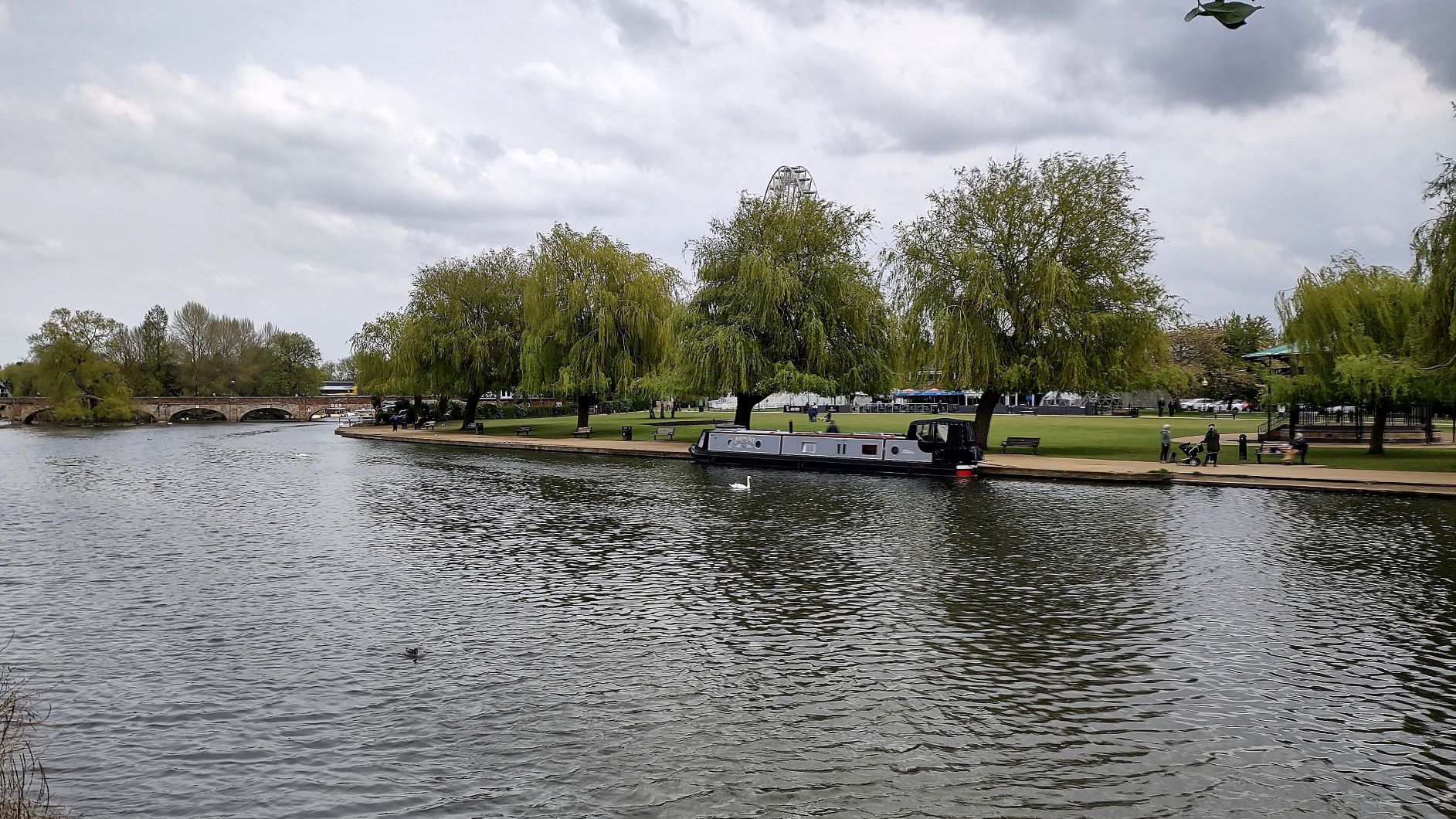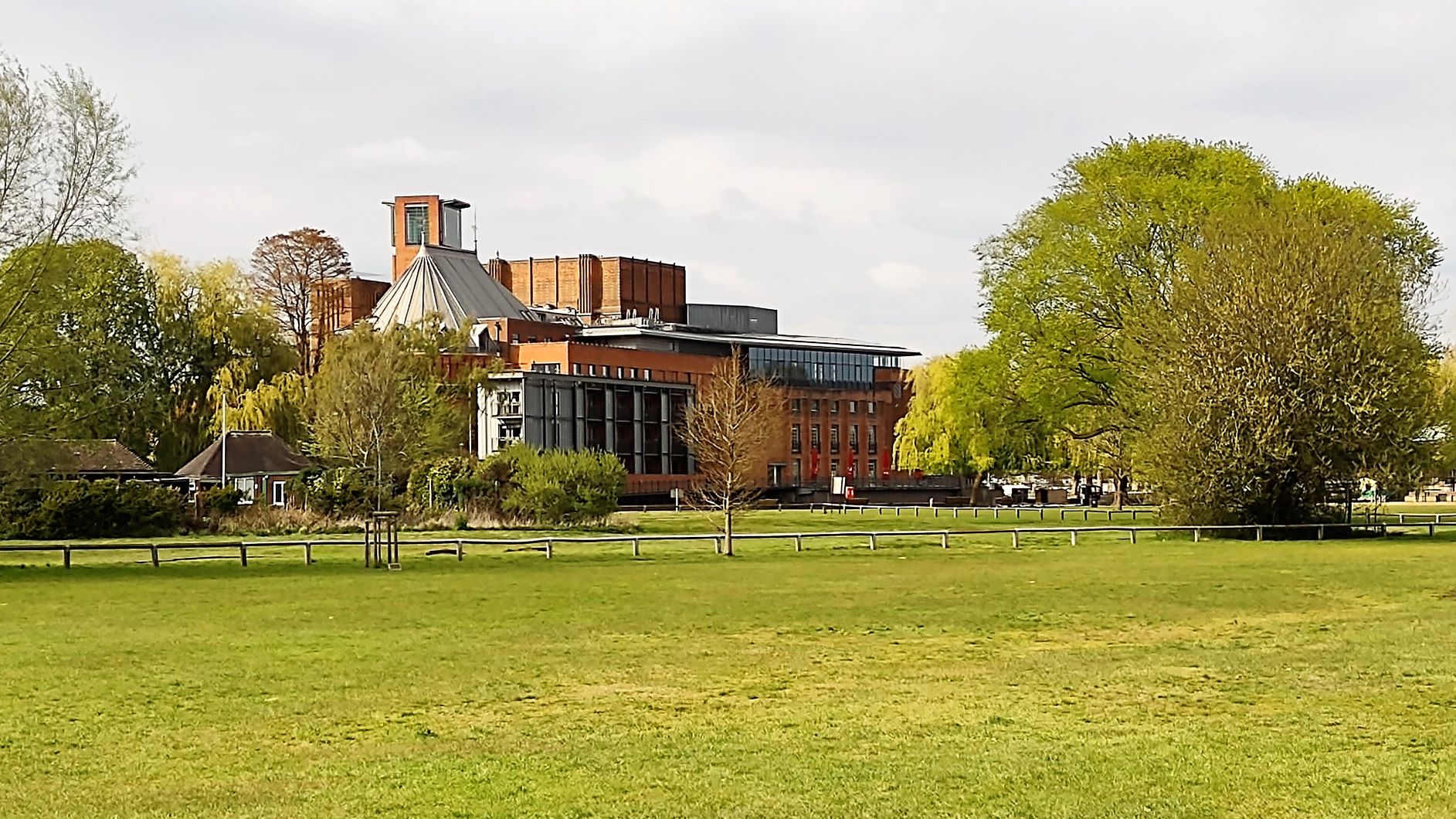Mistaken Identity
A week after we had set out the sun was still shining as, armed with a seven day license for fifty quid, we moved into the big double lock at the far end of the basin to drop down to the River Avon below. Whilst discussing our plans Sue had said we had never been on this river before. I distinctly remembered a hire boat holiday where we took a boat down onto the Avon at Bath and spent about a week on the river. Sue was right, of course. In my ignorance I had failed to realise that there is more than one River Avon. It turns out that "Avon" is a word derived from ancient Celtic languages and just means "River". In fact there are officially nine rivers called Avon in Great Britain.
Spot The Difference
Going onto any river always feels a bit strange to us at first. It is usually much wider than the canal you have come from, there is a discernible current in the water, you feel more exposed and vulnerable to the wind and you are allowed to increase your speed from four miles an hour to six miles an hour, although only downstream in this case. You have to have an anchor ready to be deployed but the main concerns are the increased likelihood of rapidly changing water levels and the issue of finding suitable mooring. We were told the water levels were a particular concern on the Avon but seemed unlikely to impact us in a sustained period of dry weather. The mooring issue was a bigger worry. There is no towpath alongside the waterway that you can just bang some pins into or metal siding to hook chains around. The banks on either side are are all privately owned and seldom suitable to moor against. You are dependent on specific points where mooring is permitted, which are few and far between and can be subject to mooring fees and time limited. If the river is very busy, as we had originally anticipated it would be, you could arrive at your planned destination and find there is simply no space at all. In the end we found any concerns about congestion were as unfounded as they had been on the Stratford Upon Avon Canal. We hardly passed another boat and the various mooring sites were all virtually empty.
Typically, the Canal and River Trust, set up expressly to take on the running of canals and rivers, does not run all the canals and rivers. A license to roam their entire estate only covers a portion of the waterways around the country and does not automatically transfer to the authority running the others, hence the purchase of an additional license. This River Avon is managed by the Avon Navigation Trust, who are another charitable foundation manned almost entirely by volunteers. Although the CRT are better known and come in for a lot of criticism the infrastructure and facilities managed by the ANT are in no better state. Broken paddles, gates that will only open half way and limited water and sanitary facilities were all in evidence here as well. Perhaps the problem is not the individual management structures but just the lack of funding to do everything needed on a part time basis.
The locks were huge, compared to those we had been handling, with a different design involving a lot more turns of the windlass and very heavy gates. The procedure was different too. The instructions were very clear that you had to use ropes fore and aft to hold the boat and not rely on a centre line alone. We spent a while scratching our heads as to how to make that work with just two of us on board. We were going down. If I got off and put the lines round the bollards I could pass the stern line back to Sue and she could let it out as the boat descended. However, if I then secured the bow line to a bollard and went to open the paddles I wouldn't be there to pay out the line and allow the bow to descend, which would obviously lead to a real disaster. If I didn't fasten the bow line and left it loose then what was the point of it? Having the boat swinging about just secured at the stern didn't sound like a good idea either.
We soon found that with such large locks the water leaving didn't really cause any problem, the boat was perfectly stable and in control without being tightly secured. We had no problems with this in any of the locks. On the two locks we descended with another boat a centre line each was ample to keep the boats to their own side and avoid the vessels banging into one another.
Going Down
All these little differences didn't take long to get used to and there was no denying that the scenery was very beautiful. We had six locks to get through on the first day but there were long stretches of just cruising. With the width of the river and the land either side being left empty since it would be subject to frequent flooding we often had a wider vista than we have on some canals and it was all the better for being bathed in wall to wall sunshine. As it was now actually warm as well as sunny it made for a perfect day.
One thing we noticed was that the inhabitants of either bank must have decided very early on that they wanted nothing to do with one another. This clearly saved them the trouble and expense of building bridges. We saw one established bridge connecting Binton with Welford-On-Avon and then none all the way to Bidford, our first evening stop. There were no more from there down to the Workman Bridge at Evesham the next afternoon except for the road bridge that carries the Evesham bypass, which was only opened in 1987. Comparatively recently the locks on the navigation may have provided some routes across and a railway bridge or two appeared but otherwise the only other crossings were a few chain or cable ferry points on the way down.
Originally, a few years ago, we would take care to have actual DVDs on board and ensure that any applications we relied on were able to run offline. Nowadays we depend much more on streaming TV and far fewer of the things we use have an offline option. As a result, our reliance on some sort of half decent mobile broadband signal is much greater. Perhaps because a lot of the habitation is set back on rising ground, the expected internet coverage on the Avon was said to be extremely limited, which meant our options for mooring were further restricted.
Our first night on the river was planned to be at Bidford On Avon. A large village or a very small town but one with public mooring and a potential internet connection, as well as a recommended fish & chip shop, essential on a Friday night. This turned out to be a good choice. There was plenty of room to moor up right beside a huge and very well-equipped park. Sports pitches, gym equipment, lots of really solid picnic benches and tables equipped with heat resistant panels for people bringing disposable barbecues and acres of just open space in a big meadow. Looking on the map it is cleverly named "The Big Meadow" and Bracken loved it.
There is one old bridge here, just upstream of the Big Meadow, that takes you across to the village, there is virtually nothing else on the left bank but flood plain. The bridge takes you to a centre that consists mainly of a couple of pubs and a number of food shops. Two Indians, a Chinese, a sort of Kebab House and the chip shop, as well as a hairdresser and the One Stop Shop are right here. They sit back across the road from The Bridge and The Frog pub, both of which have a river frontage, although only The Frog had re-opened, so far. A High Street runs off from this hospitality hub up to the church and another pub past a few small boutique shops, as well as a newsagent and a café. As far as we could see that was all the original village consisted of but around it, on the higher ground, were concentric arcs of more modern housing development that looked to be two distinct phases.
Placing an order for fish & chips to collect gave me the opportunity to sample The Frog. They had a garden on the river front with a marquee to huddle under and some open tables on a small terrace. Beside this, as the Friday night punters welcomed the weekend, a pair of builders were still hard at work, drilling and sawing, to construct wooden decking for seating and shelter, which seemed to have more sophisticated heating arrangements in the plan.
At one table near me I could not help noticing a group of mostly men, aged between twenty-five and fifty at a guess, who seemed to be a classic group of blokes meeting for a drink after work. Although there were only six or so at the table, the group make-up kept changing. Someone would leave and another one or two would arrive. The striking thing was that every time someone departed or arrived there was a round of enthusiastic hugging between them. This seemed odd behaviour for a party like this at any time, they were not a troupe of theatrical luvvies or in any way camp in their mannerisms. In this time of COVID restrictions it just seemed deliberately contrarian.
Another fine day on Saturday took us down to Evesham, which was about as far as we intended to go on this trip. Good weather made for a lovely cruise even though the locks continued to be a bit hit and miss in their operation. We came through the last three with a boat called “Masquerade”. She was crewed by an older man and his daughter, who owns and lives on her own boat but had taken the week off to give her father a hand. He was delivering the boat to Strensham on behalf of the owners and had come all the way from the River Nene, the other side of Northampton. He told us that they had only been going for a week and had been through over a hundred locks. At our pace I am pretty sure this would have taken at least a month!
Exploring Evesham
Almost as you arrive in the town you pass through Evesham Lock, sitting just beyond a large weir. Signs warn of a strong current here but you only really appreciate what they relate to when you have done it. The approach here is an awkward oblique angle into the lock and as you try to line up to enter it the boat is pushed way over to the right where a small disused arm has a couple of boats moored. We had quite a scramble to bring the nose back round in line and then push the stern over to follow us in rather than ending up broadside across the lock entrance.
Once through the lock we were quickly passing under Workman Bridge. This is not dedicated to the hardworking labourers of Evesham but named after Henry Workman, their mayor, under whose auspices the bridge was built in 1856 to replace a mediaeval crossing. At the same time the river was dredged and the spoil used to create Workman Gardens on the left bank, just beyond the bridge. All along the promenade beside Workman Gardens are rings, providing 48 hour visitor mooring as well as a couple of water taps and a boaters' rubbish point, our home for a couple of days.
The river here runs fairly straight from the north east before executing a sharp u-turn to head north again. While there is a lot of modern Evesham to the east and south of the river, the original town sits within this meander, above and to the north of it. A main road crosses Workman Bridge and climbs the hill to the High Street at the top. The old market square, mainly tea rooms and coffee shops, offers a narrow passage through to a peaceful green space with two parish churches and Abbott Lichfield's bell tower, which is all that remains intact of the original abbey, facing out over the river bend. Here the ground slopes away back down to the river at the foot of the hill.
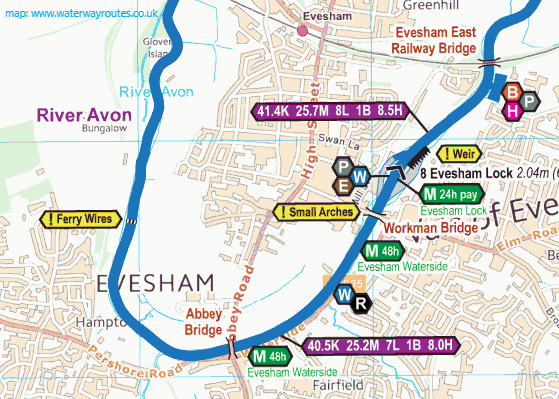 Presumably because of the risk of flooding there are huge areas of open space and recreation facilities along the river front. Abbey Park itself, on a sunny afternoon, was packed with people meeting up outside after lockdown. The ice cream van was out and there was a real holiday atmosphere.
Presumably because of the risk of flooding there are huge areas of open space and recreation facilities along the river front. Abbey Park itself, on a sunny afternoon, was packed with people meeting up outside after lockdown. The ice cream van was out and there was a real holiday atmosphere.
Further along there are tennis and basketball courts, playgrounds and the rowing club and beyond them lies Crown Meadow. This looks just like a very big open park, with trees lining the river and people walking their dogs and having picnics. Unlike most other town parks, however, here it was deemed to be completely normal to also have cars driving straight across and around the whole area, parking up just anywhere. We had to be quite careful to watch out for them coming up behind us as we walked around it.
The meadow runs down to Abbey Bridge, a recent replacement for one built in 1928, which itself pioneered the use of concrete for bridge structures and is said to have been the first concrete bridge in Great Britain. The bridge is substantial but like its predecessor is integrated with a viaduct across the flood plain as well, which makes it look much more imposing. It seemed to us that this is where the open area would end but as we approached we realised that it continues under the viaduct into Corporation Meadow and right around the bend, with a large blue-green leisure centre looking over it on the right. The people of Evesham are certainly not short of recreational opportunities or public open spaces.
Typically, we got up to the Tourist Information Office in the town centre half an hour after they closed, so we couldn't get a town trail to follow. We had a look around on our own and learnt what we could from occasional plaques. Apparently All Saints Church and Saint Lawrence Church were both built in the twelfth century to provide a place of worship for the ordinary townspeople and preserve the abbey chapel for the devotions of the monks there. However, we could find no explanation as to why two parish churches were erected right next to one another in the same period. We also could not fathom what determined which of them each member of the congregation should attend.
Wandering around, we could see the town had clearly been very prosperous but even in the sunshine, it seemed a little run down. We couldn't decide if that was a Coronavirus effect or if the decline preceded that. Certainly the most common establishments were charity shops and the only ones really doing any business on a Saturday afternoon were Costa and Wetherspoon's.
The mooring south of Workman Bridge looks directly across to Abbey Park so, with the Workman's Garden outside it made a very pleasant spot, despite nominally being in a town. There was a level of foot traffic along the promenade but mostly people stayed in the garden. From about five thirty a couple of groups of what we think were Eastern European men gathered around the concrete table tennis table a hundred yards or so away and on the Petanque court beyond it. They had some beers, fast food and what used to be called a ghetto blaster. They seemed to be settling in, so we feared the worst. In practice they were ideal neighbours. The music came on but was quickly turned down so that we could barely hear it. They seemed to stay in groups of six or less, played ping pong and enjoyed themselves peacefully while the sun went down. They left quite a while after dark, leaving very little mess behind them and we are pretty sure their presence helped to keep any more rowdy element of the local youth away.
It turned out that the bell tower continues to chime throughout the night, which we thought was unusual these days. It was far enough away for us to just notice and ignore it but it must be a bit of an issue for light sleepers around the close.
Sunday was another fine day, a bit more cloud in the morning and the same crisp air keeping the temperature down. A hard standing beside the boat and access to water was an ideal opportunity to clean that side of the boat and particularly tackle the black streaks that had appeared over the winter, moored beside the trees. We had brought some proprietary stuff to deal with them and a bucket of elbow grease and that seemed to do the job, unless you looked very hard. While I did that, Sue cleaned through the inside which was sorely needed after ten days tracking dirt through and keeping a coal fire going twenty-four hours a day. In the afternoon we did a bit more exploring but I'm sure there is more to see here once it properly comes back to life.
Heading Back
With the need to be back in Southam for second jabs etc. in early May we couldn't get much further than Evesham The only real choice was to turn back and retrace our route. The next day started dull and overcast and as the wind rose it got really cold for a while.
When we are moored up, our new pram hood has proved to be a great asset. It provides an additional room protected from the wind and rain, a useful extra 'airlock' between the outside world and the cosy interior. However, when we are moving we have to take it down. We have done this quite a few times since having it installed and you might imagine that, by now, we would have developed some sort of repeatable process. Not a bit of it. Every time we collapse it the result looks quite different. Stray bits of canvas appear in odd places, the points used to secure it against the wind seem to have moved and various things we need to be able to access or open are blocked or covered, although they were fine last time. Every time we prepare to set off we add half an hour of wondering what's happened now and making adjustments to get it into some sort of shape.
Finally, by about eleven o'clock, we were ready to cast off, take advantage of the river width for a simple U-turn and head back up to Evesham Lock. This time we were going up the locks and you definitely do not want to have the boat floating free when you open the top paddles on these chambers. The force and volume of the water would bounce the boat around all over the place and if you got underneath the inflow you would be at serious risk of sinking. In this direction, however, it was simple to see how to secure the boat with ropes at both ends to hold it in position. As the water flows in and the boat rises the rope becomes looser but you can get back in time to take up the slack until the force of the water dies down. Taking each lock slowly and carefully it was fairly easy and there were no problems.
As we carried on up the river the day got brighter and the sun came out. We stopped by one of the locks with the catchy name "Robert Aickman New Lock", also known as "Harvington New Lock".
All the locks on the river seem to have two names but we haven't been able to find out exactly why. In general one name seems to be related to a place and the other to a person and we presume the people remembered in them played some prominent role in the restoration of the navigation; Robert Aickman certainly did. It is unhelpful in that some guides and maps use one name and some the other. Few of them use the lock number and we only found one source that includes both names. As a result, you do sometimes get confused as to where you are although, in fairness that has become a much more normal state of affairs in recent years.
We had lunch in the sunshine and continued upriver past the remains of an old car, with its nose in the water, which we had noticed on the way down.
How it got there was unclear as there were no roads or tracks, although behind it was a high embankment rising some thirty five metres in a little over one hundred metres on the ground. This is Cleeve Hill and the river follows the ridge for a couple of kilometres before bending away at Cleeve House. Having cruised past this one vehicle by the waters' edge our awareness was heightened and proceeding upstream we realised that, every couple of hundred yards, there were other vehicles crashed or burned on the hillside among the trees and in one case caught in the branches of a large oak. We could only conclude that this is where the joyriders of the Vale Of Evesham come to dispose of the weekend's crop of stolen cars, although there is no public road or obvious track along the top of the ridge so how they get up there to roll them down is a mystery.
By four o'clock it was a fine, sunny afternoon and really warm away from the breeze. We were approaching Bidford again, ready to stop for the night on the same visitor moorings we had used on the way down. Before we left Evesham I had given Bidford Boats, just across the river from the moorings, a call to check if they were open and still selling diesel. The question had seemed to come as surprise to them but after a bit of head-scratching they had agreed that they were open until six o'clock and did sell diesel fuel. We should moor alongside "Kingfisher", on of their hire boats and they would deal with us there. As we approached their site we could see nowhere to pull in and no boat called "Kingfisher". With our track record we didn't want to just tie up to the wrong boat so we were in a quandary. Luckily, just before it was too late, a head popped up from an engine bay and we could ask the question. Sure enough he had been as confused as he sounded in the morning and had forgotten that "Swan" had returned the night before and was moored alongside "Kingfisher" completely hiding her from sight. We breasted up against "Swan" and got the tank topped up. There followed another rather confused session of going back and forth between huts, signing in, working out prices and tax, finding the card machine etc. We got through it in the end but it certainly didn't seem as if they went through this process very often, which seemed strange as there are very few places where boats using the river can get fuel.
Despite the faffing by half past four we were moored up precisely where we had been before, enjoying the sunshine into the evening.
Return To Stratford
Tuesday was grey and overcast most of the day with not much let up in the cold wind. We had six locks to get through and about nine and a half miles going against the current. We took it fairly slowly anyway and it all made for quite a long day. In the end, we managed to get moored up just before the heavy rain started at about five o'clock.
We had already found both the canal and the river to be strangely quiet out on the water. Another thing we found odd was that we had seen no-one out fishing since we came down onto the Avon. Throughout the entire stretch that we had travelled, there and back again, we could see these makeshift fishing platforms. They came in different shapes and sizes, some were a bit Heath Robinson and a clear health & safety issue, as were those that were dilapidated and decayed but there are a lot of them and they must take some effort to put in and maintain. This speaks to a keen and vibrant angling community along the river's banks but we had seen no-one.
Bear in mind that fishermen were one class who seemed completely deaf to the stay home mantra of the lockdown period, even though all the commercial fishing spots had closed down. We would often come across them on our daily permitted exercise camped out with a car load of equipment on the narrowest part of the towpath grudgingly shifting one buttock closer to the water to increase the space to pass from one metre to one point two metres.
One boat we did pass, just as we were leaving Welford Lock, was our old friend from Bancroft Basin, "Sun Uppers". I was immediately reminded of one item on a list of spoof insurance claim forms that used to do the rounds: "The accident was caused by me waving to the man I hit last week". We did wave and say "Hello" but we got very little response.
Just beside Weir Brake Lock, as we approached Stratford, we could see the site of Shakespeare Marina, which is currently under construction. We heard that work had been in abeyance for a while but recently they have been going full steam ahead. Looking into it, it seems outline planning permission was granted in 1974 with a variation to conditions in 2012. The site was acquired by the current developers in 2016. They began "preliminary works and services" around April this year so it does seem to have taken a while to get off the ground; even I have run projects that delivered in less time. It seemed like a vast area of earthworks covering the hillside to the east and apparently it will house two hundred and fifty boats with an expected opening in November 2021.
Passing the weir and sluice at Lucy's Mill we entered the last lock of the day and emerged to moor up alongside the Recreation Ground, taking care to keep well clear of any other boats this time. Not difficult, as there was no-one else there at all.
It might have been lonely but one thing we did have from this spot was a really good view of the Royal Shakespeare Theatre

